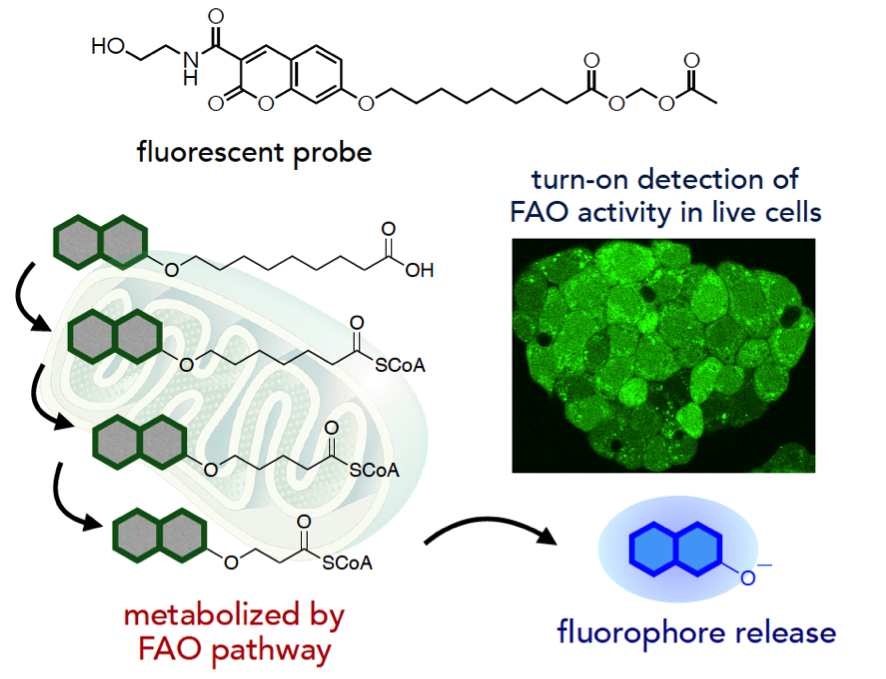RESEARCH

私たちの研究室では、自らデザインした機能性分子を自在に合成し、生体分子の解析と制御に応用するケミカルバイロジー研究を行っています。特に私たちは、ケミカルバイオロジーと創薬化学を融合させた化学薬学に特に強い興味を持って研究を進めています。最も代表的なコバレントドラッグ研究では、従来のフラスコ内の有機化学から生体内タンパク質を対象とした新しい創薬有機化学の開拓です。そのボトムは、有機合成創薬とは、我々の体の異常を治すための優れた分子の創製に他なりません。特に私たちは、タンパク質と共有結合を形成して機能を阻害するコバレントドラッグの研究を積極的に推進しています。コバレントドラッグ研究は、タンパク質を対象とした新しい創薬有機化学の開拓です。例えば、私たちは、細胞内の代謝を可視化できる新しいタイプの蛍光プローブを開発しています。
Selected Publications
Fluorescence detection of metabolic activity of the fatty acid beta oxidation pathway in living cells
Shohei Uchinomiya, Naoya Matsunaga, Koichiro Kamoda, Ryosuke Kawagoe, Akito Tsuruta, Shigehiro Ohdo, Akio Ojida
Chem Commun, 56, 3023-3026 (2020)

Detection of metabolic activity in living cells facilitates the understanding of the mechanism underlying cell homeostasis and development of chemical modulators for cell metabolism. However, fluorescent probe that can sense activity of a metabolic pathway has been poorly developed. We developed a novel fluorescent probe that can detect metabolic activity of fatty acid beta oxidation (FAO) in living cells. This probe is metabolically degraded by the sequential enzyme reactions of FAO, releasing the fluorescent coumarin as an end product of FAO. The probe can visualize activity level of FAO with turn-on fluorescence and is applicable to evaluate the effects of the metabolism-related drugs on FAO activity in cultured cells and primary hepatocytes.
Electron Microscopic Detection of Single Membrane Proteins by a Specific Chemical Labeling
Shigekazu Tabata, Marijo Jevtic, Nobutaka Kurashige, Hirokazu Fuchida, Munetsugu Kido, Kazushi Tani, Naoki Zenmyo, Shohei Uchinomiya, Harumi Harada, Makoto Itakura, Itaru Hamachi, Ryuichi Shigemoto, Akio Ojida
iScience, 22, 256-268 (2019)

Electron microscopy (EM) is a technology that enables visualization of single proteins at a nanometer resolution. However, current protein analysis by EM mainly relies on immunolabeling with gold-particle-conjugated antibodies, which is compromised by large size of antibody, precluding precise detection of protein location in biological samples. Here, we develop a specific chemical labeling method for EM detection of proteins at single-molecular level. Rational design of α-helical peptide tag and probe structure provided a complementary reaction pair that enabled specific cysteine conjugation of the tag. The developed chemical labeling with gold-nanoparticle-conjugated probe showed significantly higher labeling efficiency and detectability of high-density clusters of tag-fused G protein-coupled receptors in freeze-fracture replicas compared with immunogold labeling. Furthermore, in ultrathin sections, the spatial resolution of the chemical labeling was significantly higher than that of antibody-mediated labeling. These results demonstrate substantial advantages of the chemical labeling approach for single protein visualization by EM.
Selective and reversible modification of kinase cysteines with chlorofluoroacetamides
Naoya Shindo, Hirokazu Fuchida, Mami Sato, Kosuke Watari, Tomohiro Shibata, Keiko Kuwata, Chizuru Miura, Kei Okamoto, Yuji Hatsuyama, Keisuke Tokunag1, Seiichi Sakamoto, Satoshi Morimoto, Yoshito Abe, Mitsunori Shiroishi, Jose M. M. Caaveiro, Tadashi Ueda, Tomonori Tamura, Naoya Matsunaga, Takaharu Nakao, Satoru Koyanagi, Shigehiro Ohdo, Yasuchika Yamaguchi, Itaru Hamachi, Mayumi Ono, Akio Ojida
Nature Chemical Biology, 15, 250-258 (2019)

Irreversible inhibition of disease-associated proteins with small molecules is a powerful approach for achieving increased and sustained pharmacological potency. Here, we introduce α-chlorofluoroacetamide (CFA) as a novel warhead of targeted covalent inhibitor (TCI). Despite weak intrinsic reactivity, CFA-appended quinazoline showed high reactivity toward Cys797 of epidermal growth factor receptor (EGFR). In cells, CFA-quinazoline showed higher target specificity for EGFR than the corresponding Michael acceptors in a wide concentration range (0.1–10 μM). The cysteine adduct of the CFA derivative was susceptible to hydrolysis and reversibly yielded intact thiol but was stable in solvent-sequestered ATP-binding pocket of EGFR. This environment-dependent hydrolysis can potentially reduce off-target protein modification by CFA-based drugs. Oral administration of CFA quinazoline NS-062 significantly suppressed tumor growth in a mouse xenograft model. Further, CFA-appended pyrazolopyrimidine irreversibly inhibited Bruton’s tyrosine kinase with higher target specificity. These results demonstrate the utility of CFA as a new class warheads for TCI.


